Confused by different cookware types? Need something durable that heats evenly? Stainless steel triply cookware uses bonded metal layers for excellent performance and a long lifespan.
It’s cookware made with three layers bonded together: stainless steel inside (food contact), an aluminum core (fast, even heating), and stainless steel outside (durability, often induction-ready). This design offers balanced performance.
Before triply materials became common, I already preferred stainless steel over typical aluminum non-stick pans. My reasons were simple: fewer chemical coatings, much more durable, and less likely to bend or warp. Of course, the quality of stainless steel matters. Lower grades like 201 or 410 aren’t ideal, while 304 is the best choice for the part that touches your food.
Then, maybe a bit over ten years ago, triply construction really took off. It’s a smart way to combine the best features of different metals:
- Inside: 304 stainless steel – safe for food, doesn’t rust easily.
- Middle: Aluminum – heats up quickly and spreads the heat evenly.
- Outside: 430 stainless steel – tough, strong, and magnetic so it works on induction stoves .
This setup fixes common problems like pans heating unevenly (hot spots) or not working on induction hobs. I’ve personally used triply pots and pans for more than 12 years now. They really are excellent in terms of quality feel, how they handle, their weight balance, how long they last, and how easy they are to clean up.
Because I trust the material based on my own experience, I now also work in selling both the raw triply circles for factories and the finished cookware. Triply frying pans are a great example – they cook evenly, often need less oil, don’t burn food easily in one spot, and are healthy because there’s no coating to worry about. They’re very popular, especially in Western countries. I was just talking with a client in Sweden about a project focused heavily on triply frying pans – it shows how much demand there is globally. Let’s look closer at what makes it special compared to other options.
Is triply stainless steel cookware better than stainless steel?
Wondering if it’s worth upgrading from basic stainless steel? Standard steel is tough, but often heats poorly. Triply aims to fix that heating issue for better cooking.
Yes, generally for cooking performance. Triply’s aluminum core provides much better and more even heat distribution than standard single-layer stainless steel, reducing hot spots and improving cooking control.
When deciding between regular stainless steel cookware and triply, the main difference comes down to how they handle heat, although there are other factors too.
Comparing Heat, Durability, and More
Let’s break down the key comparison points based on my experience and what the materials offer:
- Heat Conductivity & Distribution: This is the biggest advantage for triply. Standard stainless steel on its own doesn’t conduct heat very well. This means it can heat slowly and develop "hot spots" – areas directly over the heat source get very hot while other parts stay cooler, leading to uneven cooking. Triply solves this by sandwiching a layer of aluminum (an excellent heat conductor) between the steel layers . This aluminum core spreads the heat quickly and evenly across the entire base and often up the sides (if fully clad), giving you much more consistent results .
- Cooking Performance: Because of the even heating, triply cookware generally offers better cooking performance, especially for tasks needing precise temperature control like simmering sauces or searing meat evenly . You’re less likely to scorch food in one spot while another is undercooked. While standard stainless steel can sear well due to its heat retention once hot, getting it evenly heated can be trickier.
- Durability: Both are very durable. Standard stainless steel is known for its toughness and resistance to rust, warping, and scratching . Triply cookware retains this stainless steel durability on its inner and outer surfaces . You get the strength of steel combined with the heating benefits of aluminum.
- Weight: Triply cookware is often slightly heavier than basic single-layer stainless steel pans because of the extra layers [^4]. However, it usually feels more balanced and substantial, and might be lighter than very thick, heavy-gauge single-ply stainless steel pans .
- Cost: Triply cookware is typically more expensive than standard stainless steel cookware due to the more complex manufacturing process and the inclusion of multiple materials.
Here’s a quick summary table:
| Feature | Standard Stainless Steel | Triply Stainless Steel |
|---|---|---|
| Heat Distribution | Often uneven, hot spots | Excellent, very even |
| Heating Speed | Slower | Faster |
| Durability | Very Good | Very Good |
| Reactivity | Non-reactive | Non-reactive |
| Weight | Varies, can be lighter | Generally heavier |
| Cost | Lower | Higher |
| Induction Ready | Sometimes (needs magnetic base) | Usually (magnetic outer layer) |
So, if even heating and top cooking performance are your priorities, triply is often the better choice. If budget is the main concern and you just need something durable, standard stainless steel is still a solid option.
What are the disadvantages of tri-ply stainless steel?
Tri-ply sounds great, but is it perfect? Before buying, consider that it can be heavier, cost more, and food might stick if you don’t use it correctly.
The main disadvantages are higher cost compared to basic pans and increased weight due to the layers, making them potentially cumbersome. Also, they are not non-stick like coated pans .
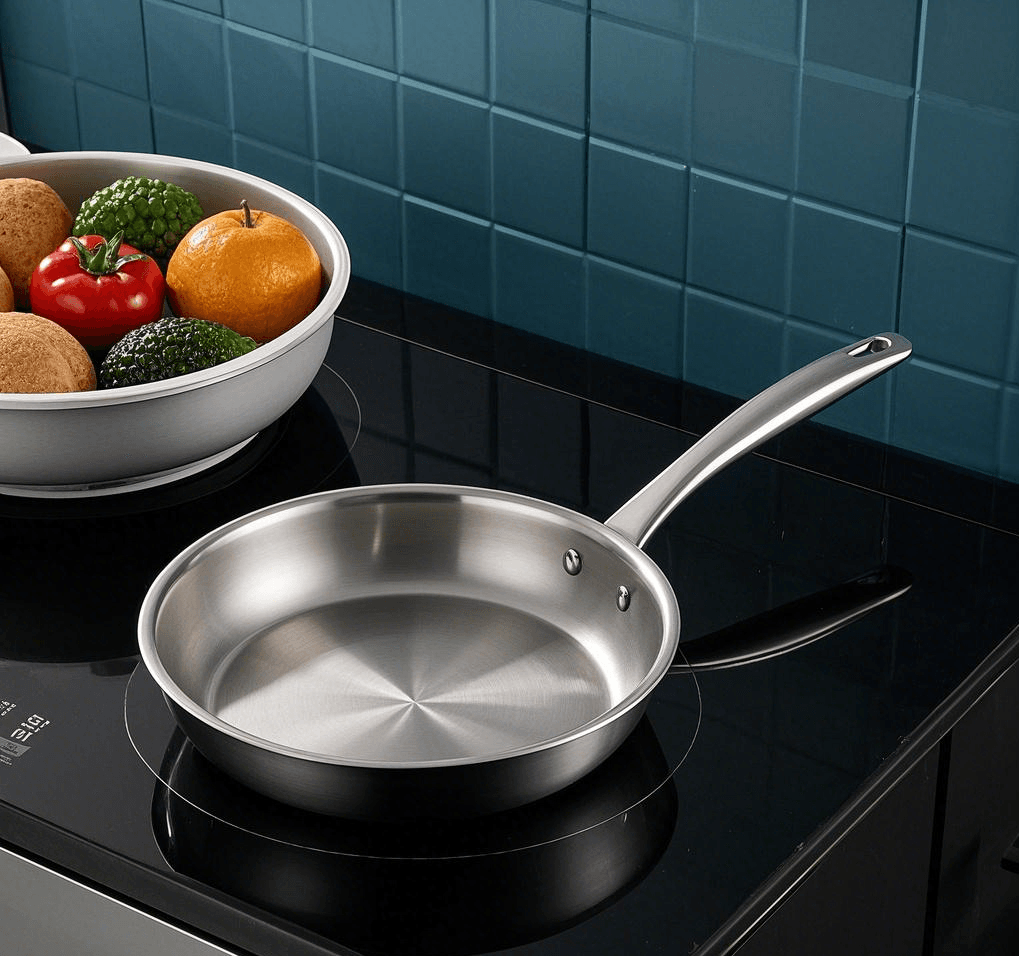 "Comparing Cookware Weights and Costs")
"Comparing Cookware Weights and Costs")
While I’m a big advocate for tri-ply cookware because of its performance, it’s fair to point out the potential downsides so you know exactly what you’re getting.
Understanding the Trade-offs
Based on customer feedback and the nature of the material, here are the main things to consider:
- Weight: Those three layers of metal add up. Tri-ply cookware is noticeably heavier than single-layer aluminum pans and often heavier than basic stainless steel pans of the same size. This extra weight contributes to the sturdy feel and helps with even heating, but it can make lifting a full pan, tossing ingredients, or washing it more difficult for some people. If you strongly prefer lightweight cookware, this might be a factor.
- Cost: There’s no getting around it – quality tri-ply cookware costs more than standard stainless steel or most non-stick options . The raw materials (good quality steel and aluminum) and the manufacturing process of bonding the layers together perfectly (cladding) are more expensive. I always tell my B2B clients that while the unit cost is higher, the value comes from longevity and performance, making it a good long-term investment for the end-user. But the initial purchase price is definitely higher.
- Sticking: This is a common point of confusion. Tri-ply stainless steel is not inherently non-stick like pans with a PTFE (Teflon) or ceramic coating. Food can stick if you don’t use the proper technique. This usually means heating the pan correctly before adding oil, letting the oil heat up, and then adding your food. It often requires a bit more fat or oil than a non-stick pan and learning not to move the food too soon, especially when searing meat. There can be a learning curve if you’re used to non-stick surfaces.
- Cleaning & Appearance: While generally easy to clean, burnt-on food or residue can require soaking and some scrubbing (using non-abrasive pads is key to avoid scratches). Stainless steel can also show fingerprints, water spots, or develop a slight rainbow or brownish tint from heat over time. This "heat tint" doesn’t affect cooking performance but can bother people who want their pans to look brand new forever. Special stainless steel cleaners can often help restore the shine.
Knowing these points helps you decide if the performance benefits of tri-ply outweigh these considerations for your specific needs and budget.
Is Triply cookware healthy?
Concerned about chemicals from cookware? Worried about scratched non-stick surfaces? Tri-ply offers a stable, non-reactive stainless steel surface for safe cooking .
Yes, tri-ply cookware is considered very healthy. The food-contact surface is high-quality stainless steel, which is non-reactive, stable at high heat, and has no chemical coatings to leach or degrade.
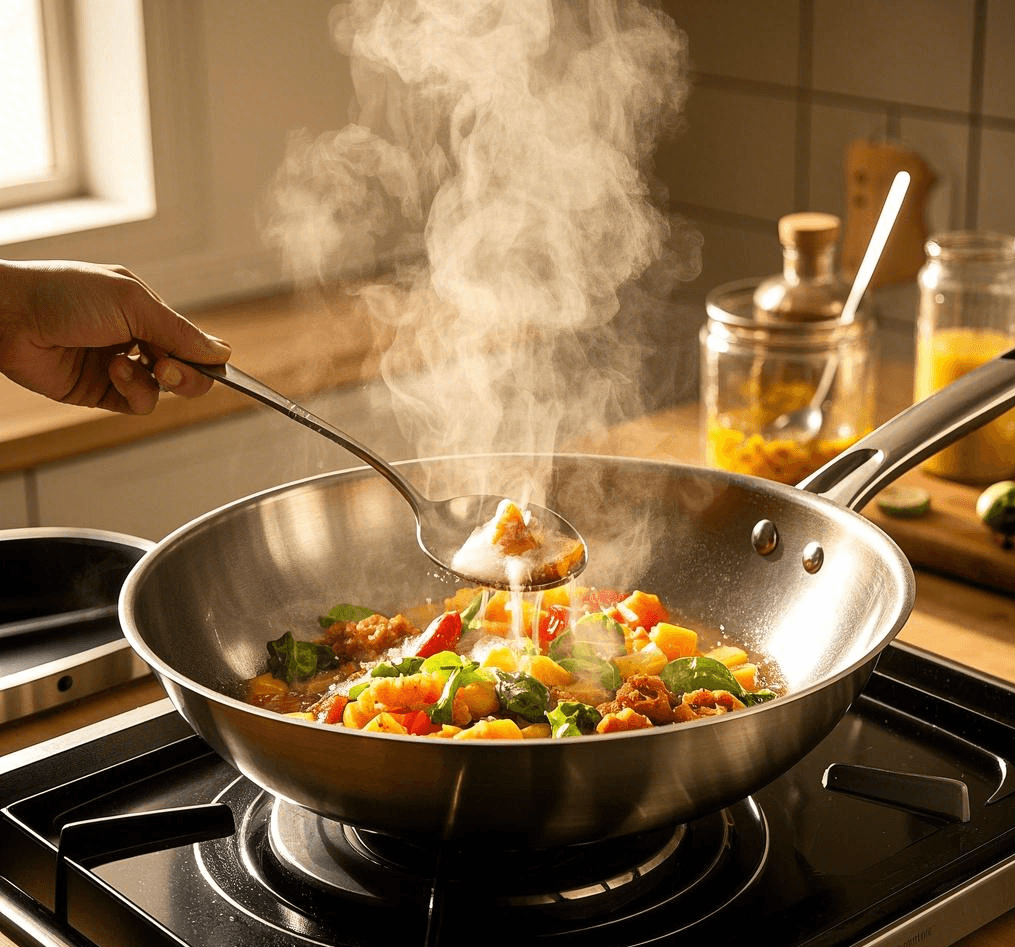
This is a really important point for many consumers today, and rightly so. From my perspective dealing with cookware materials, health and safety are major advantages of using tri-ply stainless steel.
Why Tri-Ply is a Safe Choice
Here’s a breakdown of why I consider tri-ply a healthy option for kitchens:
- Non-Reactive Surface: The inner layer, the one your food actually touches, is typically made from high-quality 304 stainless steel (often called 18/8 or 18/10). This means it won’t change the taste or color of your food, nor will it leach metal ions into your meal.
- No Chemical Coatings: Unlike many non-stick pans, tri-ply cookware has a pure stainless steel cooking surface. There are no synthetic coatings like PTFE (Teflon), PFOA, PFAS, or similar chemicals applied. This eliminates concerns about these coatings potentially scratching, flaking off into food over time, or releasing fumes if the pan is accidentally overheated. It’s just solid, stable metal.
- High Heat Stability: Stainless steel and the aluminum core are stable materials that can handle high cooking temperatures needed for searing or frying without breaking down or releasing harmful substances. The cookware maintains its integrity and safety even under intense heat (though excessive heat can cause discoloration, it doesn’t make it unsafe).
- Durability and Hygiene: The hard, non-porous stainless steel surface is resistant to scratches and corrosion. This durability means it stays smooth and intact for a long time, preventing food particles or bacteria from getting trapped in tiny cracks or pits. It’s easy to clean thoroughly, contributing to good kitchen hygiene.
In my experience supplying materials for cookware, food-grade stainless steel like 304 is a benchmark for safety. Tri-ply construction simply uses this safe material intelligently, combining it with aluminum for better heating, without compromising on health .
Is Triply better than aluminium?
Aluminum pans are light and heat fast, but often warp or scratch easily. Is triply the superior choice? Triply uses aluminum’s heat benefits but protects it with durable steel.
Yes, triply is generally better than plain aluminum cookware. It offers aluminum’s fast heating via its core, plus the durability, non-reactivity, and warp resistance of stainless steel, making it longer-lasting and more versatile.
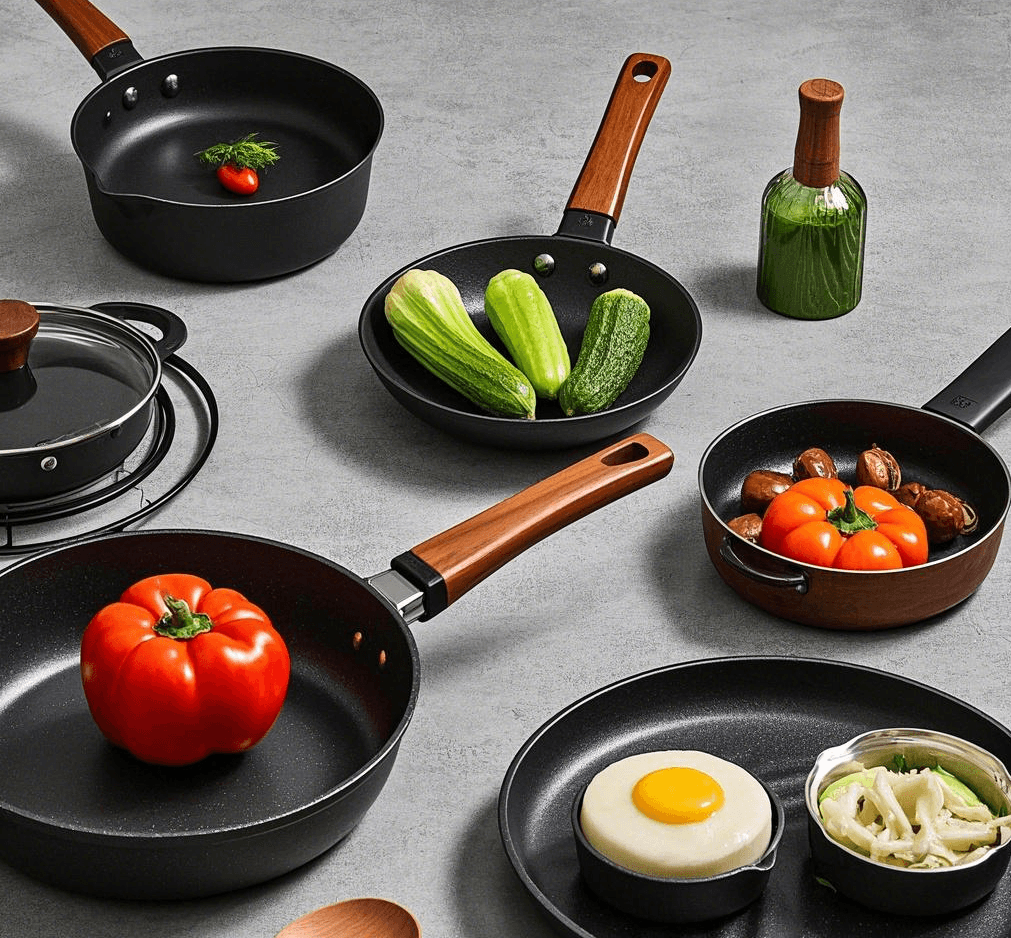
Comparing triply cookware directly to standard aluminum cookware highlights several key differences, mostly showing advantages for the triply construction.
Aluminum’s Speed vs. Tri-Ply’s Strength
Let’s look at how they stack up:
- Heat Conduction: Plain aluminum is an excellent heat conductor – it heats up very quickly. Triply cookware cleverly incorporates this benefit by using aluminum as its core layer. So, you still get fast and responsive heating, similar to aluminum, but with added advantages.
- Heat Distribution: While aluminum heats fast, thin aluminum pans can sometimes develop hot spots or heat unevenly. The combination of the aluminum core and the stainless steel layers in triply tends to result in more even heat distribution across the entire cooking surface compared to many basic aluminum pans.
- Durability: This is a major win for triply. Standard aluminum is a relatively soft metal. It scratches easily, dents if dropped, and is prone to warping, especially when exposed to high heat or sudden temperature changes (like putting a hot pan in cold water) . Triply cookware, with its stainless steel layers sandwiching the aluminum, is far more resistant to scratching, denting, and warping. It’s simply a much tougher, longer-lasting construction.
- Reactivity: Bare aluminum can react with acidic foods (like tomatoes or lemon juice) or alkaline foods, potentially altering the taste of the food and discoloring the pan. While anodized aluminum mitigates this, triply cookware avoids the issue entirely by having a non-reactive stainless steel interior surface.
- Induction Compatibility: Most standard aluminum pans do not work on induction cooktops because aluminum is not magnetic. Triply cookware usually has a magnetic stainless steel (like 430) outer layer specifically designed for induction compatibility.
- Maintenance: Triply cookware is generally easier to maintain over the long term. It resists staining better than aluminum and doesn’t require special considerations regarding acidic foods. While cleaning stuck-on food might take effort on both, the durability of triply’s steel surface holds up better to regular use and cleaning.
In short, triply cookware takes the primary advantage of aluminum (fast heating) and combines it with the superior durability, non-reactivity, and often induction compatibility of stainless steel, making it a better overall choice for most cooking needs .
Conclusion
Stainless steel triply cookware features three layers for even heating, durability, and health safety. It generally outperforms standard stainless steel and aluminum, justifying its higher cost for serious cooks.

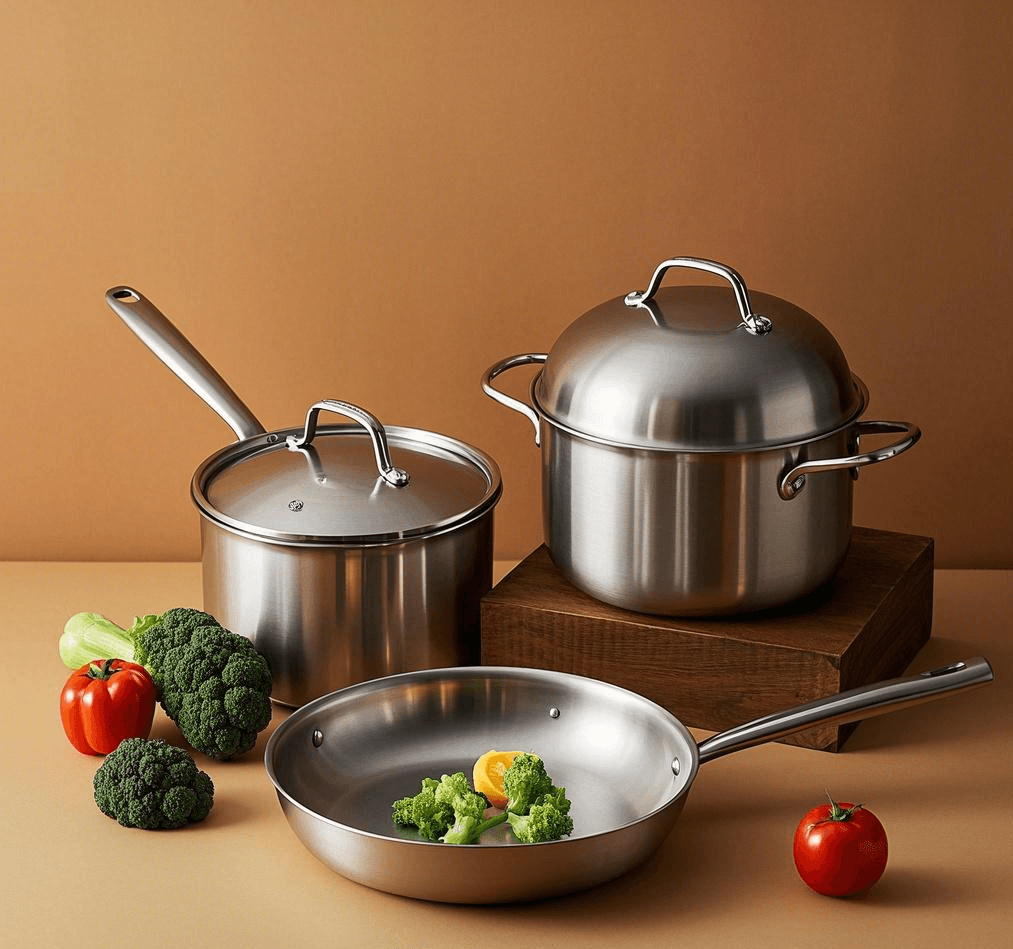

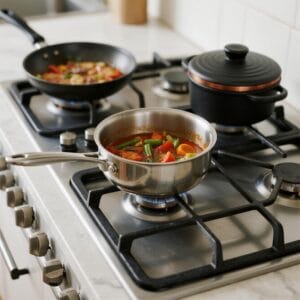
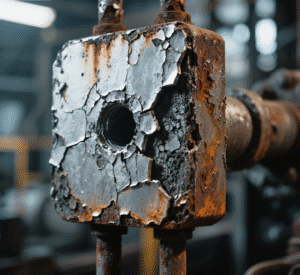
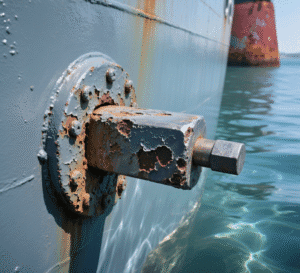
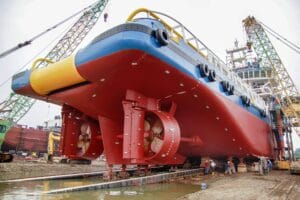
One Response